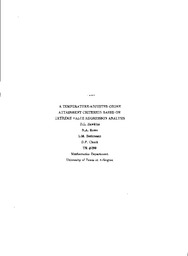| dc.contributor.author | Hawkins, D. L. | en |
| dc.date.accessioned | 2010-06-14T16:35:03Z | en |
| dc.date.available | 2010-06-14T16:35:03Z | en |
| dc.date.issued | 1993 | en |
| dc.identifier.uri | http://hdl.handle.net/10106/2498 | en |
| dc.description.abstract | **Please note that the full text is embargoed** ABSTRACT: We propose a new statistical methodology to adjust observed peak ozone levels to "normal" meteorology (say, temperatures) across the year for a given site. The adjusted ozone levels can be used to establish a yearly ozone attainment criterion without undue influence of meteorology. They can also be used to estimate ozone trends resistant to meteorological influences. The adjustment process is based on an extreme value regression model of the relationship between peak ozone, temperature and various precursors of ozone. The proposed temperature-adjustment criterion is applied to data for seven sites in Los Angeles County for each of the years 1989-1993, and graphs displaying the outcome of the proposed criterion with that of the current EPA criterion are provided. Details of the statistical methodology involved in extreme-value regression analysis are given in a technical appendix. | en |
| dc.language.iso | en_US | en |
| dc.publisher | University of Texas at Arlington | en |
| dc.relation.ispartofseries | Technical Report;299 | en |
| dc.subject | Meteorology adjustment | en |
| dc.subject | Weibull distribution | en |
| dc.subject | Maximum likelihood estimation | en |
| dc.subject | Los Angeles county air quality | en |
| dc.subject.lcsh | Mathematics Research | en |
| dc.title | A Temperature-Adjusted Ozone Attainment Criterion Based on Extreme Value Regression Analysis | en |
| dc.type | Technical Report | en |
| dc.publisher.department | Department of Mathematics | en |

